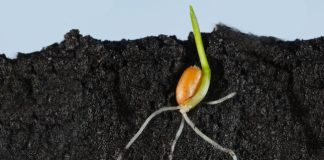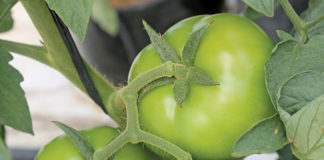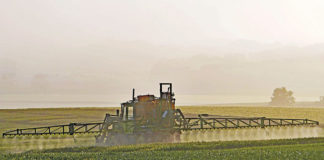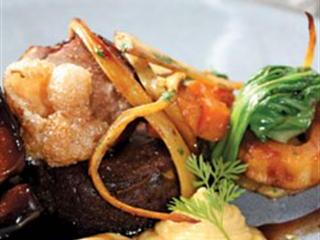
It’s not often that a visit to a gourmet restaurant begins with a tour of a worm farm. But for Delaire Graff Estate in Stellenbosch, the art of seamless blending doesn’t only apply to fine wines. Laurence Graff, chairperson of Graff Diamonds International, acquired the estate in 2003 and vowed to transform it into South Africa’s most desirable art, hospitality and wine destination, and he’s done just that.
The estate has even managed to open a diamond saloon and imported clothing boutique in the main building, without giving the space the feel of a hotel lobby. And alongside its vineyards, two restaurants and a wine tasting centre, the estate is now growing its own organic fresh produce in a food garden and greenhouse.
Food garden inspiration
“It was our executive chef Christiaan Campell’s idea to start the food garden and put up the greenhouse,” says estate manager Casper Geldenhuys. “He decided it would be fantastic if we could grow our own vegetables for the restaurants on the farm.”
Christiaan is passionate about using ethically sourced, seasonal ingredients. He oversees both restaurants on the estate, the flagship Delaire Graff Restaurant and the Asian-inspired Indochine.
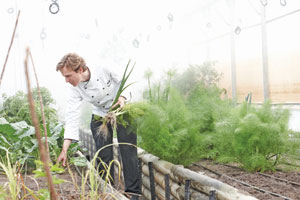
Executive chef Christiaan Campbell harvesting vegetables for the day’s dishes. Courtesy of Delaire Graff Estate
The food garden isn’t large enough to grow all the fresh produce the restaurants use, and is used to supply certain staples and ingredients that are often hard to source locally. Delaire Graff’s biodynamic greenhouse and gardens supply 80% of Indochine’s fresh produce needs, including Asian greens such as tatsoi and bok choi. The main restaurant supplements what’s harvested on site with vegetables grown under organic principles on the La Motte Estate in Franschhoek.
For all the other fresh ingredients Christiaan relies on local producers. “Both at home and in the restaurants, I lean towards organic ingredients and principles,” he explains. “At the very least, I only use meat that is free of hormones and antibiotics and sourced from pasture-reared, free-roaming animals exposed to natural sunlight.
“Going green is a process. Organic, farm-to-fork eating is gaining traction slowly in South Africa. I spend a lot of time getting to know trustworthy suppliers and continually searching for new ones, from the Garden Route to the KwaZulu-Natal Midlands and beyond.”
Holistic, biodynamic management
The vegetable beds in the garden and greenhouse are elevated and made from old vineyard poles, says Casper. The team grows about 20 different types of vegetables in the 30m2 garden and 40m2 greenhouse. The vegetables in the garden and the greenhouse are farmed biodynamically, which means that Casper follows an holistic, organic approach that doesn’t just focus on what type of fertiliser and pest and disease control agents get used during production, but also emphasises the relationship between the vegetables and the environment in which they’re grown.
As a guiding rule, any production management decision must be to the benefit of the vegetables, the soil, the air and the organisms that live in the soil, explains Casper. The vegetable beds are lined to suppress weeds and prevent the soil from overflowing during irrigation. They are filled with a growing medium mixture of 70% sand and 30% compost to allow proper drainage, and are also fitted with drainage pipes.
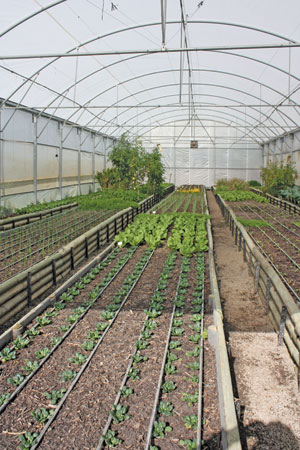
Some of the more delicate vegetables are grown in the greenhouse, where the humidity can be controlled to a certain degree.
Irrigation is done via drip lines and irrigation scheduling is done to preserve water. “The irrigation system runs from 7am to 5pm and the vegetables are irrigated once every half-hour for two minutes,” says Casper. “We reduce this amount in the winter and on very warm days we might increase it.”
No chemicals are used on the vegetables. If Casper and his team do encounter problems with pests or diseases, which rarely happens, they use a spray solution of one tablespoon of dishwashing liquid in 20l of water to treat the problem. Plant rests are retained in the soil after harvesting, and the soil is left to rest for about one week before a new batch of vegetables is planted. Before planting, the vegetable beds are drenched with worm tea (vermileachate) − also produced on the farm.
The worms
One year ago Casper started farming with worms experimentally, because he believed producing vermileachate would be more cost-effective than buying in organic fertiliser for the vegetable garden. It’s turned out to be a very successful venture. “It will cost about R50 000 to develop the worm farm and after that your maintenance costs are very low,” he explains. The worm farm is run in worm beds situated just behind the greenhouse.
These days, it produces enough vermileachate to supply both the garden and the greenhouse. “We have eight beds or bins that make up the worm farm,” says Casper. “They’re roughly 1,5m by 1,5m from front to back and side to side and 1,8m deep.”
In summer the compost in the worm beds is kept moist. Water is supplied through overhead sprayers that run for half an hour every three to four hours. This also helps regulate the temperature in the bins, because the worms would die if they got too warm.
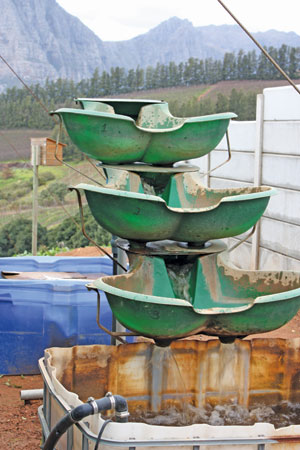
Casper says it’s important the worm tea is properly aerated before it’s used on the plants − hence this contraption. During the aeration process the worm tea is diluted with water at a rate about 1:10.
In winter the rainwater is usually enough to keep the compost moist. “During summer the worm farm produces roughly 50l/day of worm tea and in winter the production fluctuates according to the amount of rain we receive,” says Casper. “The worm tea gets aerated and diluted with water at a rate of 1:10 and we apply as much as we produce to the vegetable beds.”
Bringing things full circle, the plant waste from the vegetable garden and the restaurant kitchens is used as food for the worms.
“We put just about all the waste we generate into the worm farms, but you can’t feed the worms anything very acidic, like lemon and potato peels. We also don’t use plant rests containing seeds, because they’d germinate and start growing,” he says.
Once a year they work vermicompost produced in the worm farm into the vegetable beds.
Art in the garden
Since Laurence Graff took the helm, the estate has been deluged with artworks, mostly by local artists, which complement award-winning landscaper, Keith Kirsten’s design of the gardens and terraces. The estate gives the impression of being an indoor/ outdoor art gallery in motion, where even grape picking becomes a work of art in progress.
It should come as no surprise, then, that the food garden was designed not only to produce vegetables, but also as a visual feature − taking the idea of “eating with your eyes” to a new level. The only thing left to round off the Delaire Graff sensory experience is a sniff and a sip of one of the estate’s celebrated wines.
Contact Casper Geldenhuys on 021 885 8160 or email geldenhuys@ delaire.co.za











